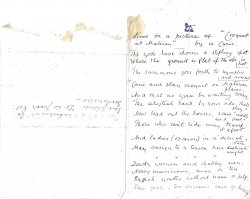
[Croquet in the Raj.] Anonymous nineteenth-century manuscript poem titled ‘Lines on a picture of “Croquet at Materan” [Matheran hill station] by a Cynic.’ With cartoon of bewhiskered man behind mask of comedy.
Although there is no clear connection, the present unpublished poem dates from around the same time as Edward Lear was drawing watercolours in the place referred to in it. Vidya Dehejia’s‘Impossible Picturesqueness / Edward Lear’s Indian Watercolours, 1873-1875’ (1989) describes how Lear visited ‘The two small hill-stations of Matheran and Mahabaleshwar near Bombay’. Of the former Lear wrote: ‘Matheran by the bye, has most probably been the original Eden - I don’t mean the first Lord Auckland, - but Paradise -’. More to the point, Lear was ‘amused to find that Matheran had a croquet ground, ‘a place set apart for Great Britainish games, and where T is made o’ the evenings, and sports played.’ 4pp, 12mo. Bifolium. Text and cartoon clear and complete, but on paper of poor condition, aged and worn with damage at head of both leaves, which are nearly detached from one another. The only evidence with regard to authorship is the fact that the paper carries a blue crest of a lion statant. First page headed: ‘Lines on a picture of “Croquet at Materan” by a Cynic.’ The poem is forty lines long and divided into four sections. Cultured and amusing, it is well worthy of publication. It begins: ‘The gods have chosen a stifling spot / Where the ground is flat if the air is hot / The summons goes forth to nymphs and swains / “Come and play croquet on Materan plains, / and that no grace be wanting today, / The celestial band by your side shall play.” / Now lead out the orses, sound “saddle and boot.” / Those who can’t ride may tramp it afoot. / And ladies (of course) in a “delicate state” / May consign to a tonjon their duplicate weight.’ The second section reads: ‘Dowdy women and shabby men, / Noisy musicians, nine or ten. / Raffish youths without name or pelf, / Raw girls, too conscious each of herself. / Respectable prosers, you there may see / And virtuous dames with babes on their knee. / There’s a Member of Council with gouty toe - / How far on shall the catalogue go? / Tattoos and coolies complete the scene / Such is the group on the croquet green.’ Lucretian reference in conclusion: ‘De fonte leprosum (’twas long said) / Surgit amari aliquid. / The grapes for a while with joy you press / But the last of their savour is bitterness.’ Beneath this, at the foot of the third page is a small but very well drawn image of a bewhiskered Victorian head (self-portrait by author?) holding before his face a moon-shaped mask of comedy. For more information see ‘Matheran Hill: Its People, Plants, and Animals. By J. Y. Smith, M.D., Bombay Medical Staff’ (2nd ed., Bombay, 1881). The fourth page of the bifolium has a short note in another hand, as follows: Read this and return it to me please. It is poor Ed. Howards- See Images.


